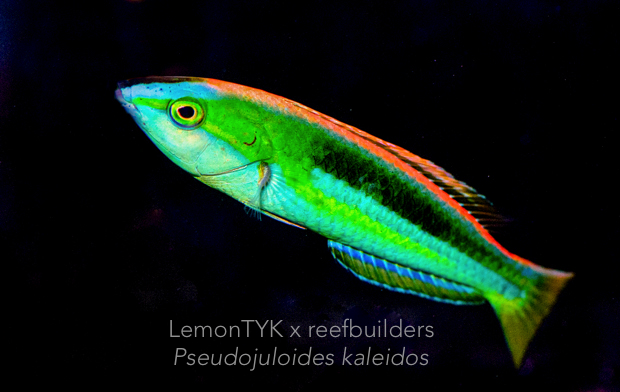Of all the labrids that enter the trade, none are quite as refreshing and unorthodox as Pseudojuloides. Wrasses are social butterflies that are found in haremic groups. usually of a single male and multiple females. As such, maintaining a species of your choice in such a setting is one of the many joys a marine aquarium has to offer. Unfortunately, the wide availability and precedence of charismatic genera like Cirrhilabrus and Paracheilinus often shadow the existence of potential candidates, some of which are just as opulent or perhaps even more intriguing. Pseudojuloides is one such genus, and Pseudojuloides kaleidos, whose name when translated to english means “beautiful form”, is a truly splendid and rather infrequently seen species that is just as worthy as any fairy wrasse.

Pseudojuloides kaleidos is a rather interesting member of the cerasinus complex. The males cannot be mistaken for any other species for the possession of a salmon stripe running along the dorsal fin base. Like all other male members of this complex, it has a modified lateral stripe when compared against the parental P. cerasinus. In P. kaleidos, the lateral stripe is present but variably coloured, often in blue but sometimes yellow. Above it lies a transverse sooty belt of varying intensity, with terminal males possessing a more complete and solid stripe. Pseudojuloides kaleidos is also unique in being the only member of its genus to span two oceans in its distribution, with Maldives being the type locality.
P. kaleidos is by and large an Indian Ocean species, being found in the Western Indian Ocean and stretching all the way to Java and Sumatra where it is at the eastern limit of its range. Passing this barrier into the Pacific Ocean, the species is represented in West Papua, Halmahera and the Lesser Sunda archipelago. The unusual geographical distribution of this fish may account for two distinct species in the future, with the Pacific Ocean form being a possible cryptic species.

The pencil wrasses are not nearly as popular as some of their more charming cousins. No doubt they may need a little more work and effort in the beginning, especially with transitioning into an aquarium life. However when collected and treated properly, we’ve seen first hand how these can and will make very hardy pets. Like all Pseudojuloides, P. kaleidos requires sandy substrata for burying and hiding when threatened or to sleep, preferably comprising of fine and loose media. The females as with all others in this complex is uniformly orangey-pink, fading to a lighter shade ventrally.

We’re currently on site in Bali Aquarium, in Bali, where these beautiful specimens are currently in stock. Being in an export facility so close to the first chain of custody is an eye-opening experience that not many will get to witness. Having spent so little time between the ocean and their current holding facility, these fish are as fresh as they can be and in perfect health, with excellent feeding response and behaviour. It just goes to show that “difficulty” is a relative term, and when handled properly from exporter to consumer, even the most touchy Pseudojuloides can do well.
Why is no one keeping P. kaleidos again? Unbelievable!



